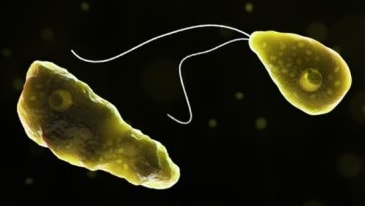Key points
- Amebic meningitis is rare.
- The ameba lives in warm fresh water and soil around the world.
- Diagnosing amebic meningitis can be hard.
- Healthcare providers can treat these infections with multiple medicines, but they are usually deadly.

What it is
Primary amebic meningoencephalitis (PAM) is a rare brain infection caused by Naegleria fowleri.
N. fowleri is a free-living ameba. An ameba is a single-celled living organism that is too small to be seen without a microscope.
Symptoms
In its early stages, symptoms of PAM are typical meningitis symptoms. After the start of symptoms, the disease progresses rapidly.
When to seek medical care
Anyone with symptoms of meningitis should see a healthcare provider right away. This is especially true if you have been swimming in warm fresh water recently. A healthcare provider can determine if you have meningitis, what's causing it, and the best treatment.
Complications
Death usually occurs within 5 days (range 1 to 18 days) of the start of symptoms.
Exposure risks
Sources of infection
N. fowleri lives in warm fresh water and soil around the world.
Risk factors
Fresh water exposure
Most Naegleria infections occur after people swim or submerge their heads underwater. However, PAM may also occur when people use contaminated tap water to
- Cleanse their noses during religious practices
- Irrigate their sinuses (send water up the nose)
Geographic location
In the United States, most infections have been linked to swimming in southern states. However, evidence suggests the range of N. fowleri is expanding northward as the climate warms.
How it spreads
N. fowleri infects people by entering the body through the nose, usually while swimming. The ameba travels up the nose to the brain where it destroys the brain tissue and causes swelling of the brain.
How it doesn't spread
People cannot get infected with N. fowleri from drinking water contaminated with the ameba.
People also do not spread the ameba or PAM to others.
Reducing risk
Personal actions to reduce the risk of N. fowleri infection should focus on limiting the amount of water going up the nose.
Testing and diagnosis
PAM is difficult to diagnose because of the rarity of the infection and the non-specific early symptoms.
Treatment and recovery
Several drugs are effective against N. fowleri in the laboratory. However, their effectiveness is unclear since almost all infections have been deadly, even when people were treated.
- In U.S. English, the single-celled living organism described here is an ameba. The word amoeba, with an "o", is used as part of a scientific genus name (such as Amoeba or Acanthamoeba). In British English, both the generic organism term and genera names are spelled amoeba with an "o."
